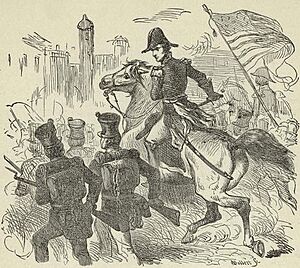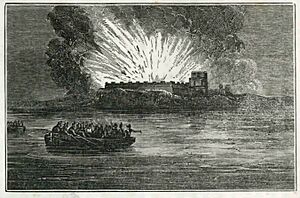Mateo González Manrique facts for kids
Quick facts for kids
Mateo González Manrique
|
|
|---|---|
| 10th Spanish Governor of West Florida | |
| In office 1813–1815 |
|
| Preceded by | Mauricio de Zúñiga |
| Succeeded by | José de Soto |
| Personal details | |
| Profession | Soldier and statesman |
| Military service | |
| Allegiance | Spain |
| Branch/service | Spanish Army |
| Commands | Spanish Florida |
Mateo González Manrique was a Spanish soldier and leader. He served as the governor of West Florida from 1813 to 1815. During his time as governor, he helped the British during the War of 1812. He let British soldiers use forts in Pensacola, which was the capital of West Florida. He also gave them troops and enslaved people to help their fight against the Americans. This made Andrew Jackson, an American general, very angry. Jackson invaded Pensacola in 1814, but he gave the city back to Manrique after the British left.
Contents
Early Life and Military Career
Mateo Manrique joined the Spanish army when he was young. He worked his way up to important ranks, like lieutenant colonel and sergeant major. In 1813, he was chosen to be the governor of Spanish West Florida.
Governor During the War of 1812
Even though the Spanish government was officially neutral during the War of 1812, Governor Manrique helped the British. He gave them supplies and let them use Spanish forts. These forts included Barrancas and Saint Michael. He also allowed the British to supply their Native American allies.
British Troops Arrive in Pensacola
A historian named Sean Michael O'Brien says that Manrique was worried about an attack from American forces. Because of this, he invited Edward Nicolls, a British officer, to bring his troops to Pensacola. The British soon took control of the port.
Nicolls tried to get the Seminole people to join the British against the United States. He worked from a place called Prospect Bluff, which he took over in April 1814. In August, Nicolls arrived at Prospect Bluff with 300 British uniforms and 1,000 guns. Manrique knew the Americans were a threat to Florida. He asked for British forces to be moved to Pensacola. Manrique worked with Nicolls, letting him train and arm Creek refugees.
Besides the Seminoles and Creek, Nicolls and another British officer, George Woodbine, recruited about 500 Red Sticks (also called "Redsticks"), Seminoles, and Black people in Pensacola. They were to serve in the British Army against the Americans.
Andrew Jackson's Warnings
Andrew Jackson was an American general. He was very critical of Manrique for letting British agents work in Pensacola. Jackson warned Manrique that he would hold him responsible for any harm caused to American citizens. He also said he would encourage Native Americans to get revenge on Manrique.
Peter McQueen, a leader of the Creek and Métis people, decided to fight the Americans. The Americans were often entering Creek lands. McQueen demanded that Manrique give him ammunition. He warned that he would burn Pensacola if the governor did not help. Manrique told his leaders about McQueen's plan to start a war against the Americans. Manrique saw the Red Sticks as important allies against the American forces, even though he had sent Spanish troops against them at first.
Jackson Invades Pensacola
Jackson believed that the British were working with the Spanish and the Creeks against American interests. He demanded that Manrique force them out of Florida. Then, Jackson led an American army to take the city. They arrived on November 6, 1814. During the battle, the Spanish soldiers did not fight much against Jackson's attack. The British then left Fort Barrancas and fled Florida. They took several hundred Native Americans with them on a British ship. Jackson felt he had stopped the plan against the Americans. He then returned Pensacola to Manrique.
After the Battle
According to historian Eric Beerman, in December 1814, before the Battle of New Orleans, Nicolls moved back into Pensacola. He took Spanish soldiers and enslaved people as prisoners. He planned to use them against the Americans in the New Orleans campaign. However, Andrew Jackson returned to Pensacola with his forces. This forced the British to retreat. Nicolls had to keep the prisoners at the British headquarters at Prospect Bluff, about 250 kilometers east of Pensacola.
Manrique sent Lieutenant Luis Urcullú with ships to try and get the prisoners back, but he was refused. After the British lost the Battle of New Orleans in January 1815, Manrique told Captain Vicente Sebastian Pintado to go to Apalachicola. He was to talk with British vice-admiral Sir Alexander Cochrane. Cochrane agreed with Pintado. He ordered that all Spanish troops and enslaved people taken by the British be returned to Pensacola. They were brought back on one of his ships, led by Richard Spencer.
Manrique's time as governor of West Florida ended in 1815. He was replaced by José de Soto.
See also
 In Spanish: Mateo González Manrique para niños
In Spanish: Mateo González Manrique para niños




